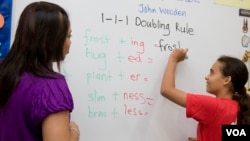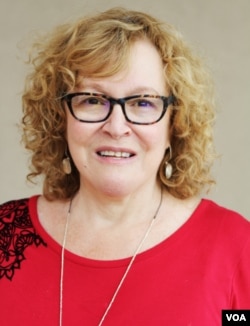Laura Grey is proficient in five languages: English, French, Spanish, Italian and German. She is also learning Russian, Mandarin Chinese and Dutch. She is doing this although she has a learning disability.
A learning disability is a condition that makes learning difficult.
Grey has dyslexia, a learning disability that makes reading, writing and spelling difficult.
“I was an early reader so nobody thought that I was dyslexic for a long time,” Grey said. “They had just thought that I had terrible handwriting and was a bad speller. Not living up to my academic potential.”
The National Center for Education Statistics says that 13.8 percent of students learning English in the United States have a disability. The statistics include both physical and learning disabilities.
What is a learning disability?
People with learning disabilities can have trouble reading, writing, spelling or understanding texts. They may have a hard time processing sounds or calculating numbers. Disabilities can be mild or severe.
Priscillia Shen is the Assistant Head of DAS Academy. The Academy is part of the Dyslexia Association of Singapore.
She said, “Every dyslexic learner is different.”
Shen said, students with mild dyslexia may do well in primary school, but may face problems in higher levels of education.
Shen believes that lessons need to fit the needs of individual students.
Multisensory teaching can help
Brenda Bernaldez is a specialist for the Office of English Language Programs in Mexico. She has taught English to students of all ages.
Bernaldez said a multisensory approach to learning English could help students. She explained that this method includes using visual, auditory and kinesthetic tools. Kinesthetic tools are activities in which students move, play or act.
This approach can involve teaching vocabulary words with pictures or using movable tiles to show how words are formed.
Strategies: reading and using words is important
Lía Kamhi-Stein is a professor at California State University in Los Angeles. She is an English language teacher who works with students struggling to read.
She said students with mild learning disabilities need to “develop the love for reading” in order to read better.
Kamhi-Stein said, the students should choose what they want to read whether it is comics or books about animals.
She also said that reading with someone else can help students hear how words sound.
In addition, she said students should learn text structures. For example, some texts have problem-solution structures where the problem is at the beginning and the solution is at the end. Students who know these structures can find information faster because they know where to look.
Kamhi-Stein also said that each lesson’s vocabulary needs to be from readings in the lesson and the vocabulary needs to be repeated.
“If what you are going to do is expose the kid to a vocabulary word one time, then that vocabulary word is not going to stick,” she said.
Strategies: designing lessons for learners with disabilities
Although Laura Grey speaks many languages, her grades would not have suggested this ability. She said writing and spelling—which she struggles with—usually affect students’ grades the most.
Grey said that language learning also involves speaking and listening which affect grades less.
Priscillia Shen said, DAS designs lessons for students’ learning needs. DAS might start, for example, with only listening and speaking.
Brenda Bernaldez encouraged students with learning disabilities to discover what learning methods work for them. She said students should then ask teachers to use those methods in class.
Sara Kangas is an assistant professor at Lehigh University in the state of Pennsylvania. She has researched English language learners with learning disabilities.
She said, many schools only place students with learning disabilities into Special Education classes and not English language classes.
Kangas said she hopes people who work in Special Education and English language teaching can collaborate to help these students.
Strategies: learning apps are good tools
Not all schools around the world provide special education however.
Brenda Bernaldez said, “If you are, as a student, trapped in a situation where you cannot ask for anything, I would say try technology to help you deal with it.”
For students struggling to read and write, Bernaldez suggested using voice recorders to take notes. She said there are apps like Evernote that let students record voice notes and organize them.
Lía Kamhi-Stein said apps like Quizlet are useful because students can learn vocabulary by reading and hearing words and looking at pictures.
Laura Grey said she likes Duolingo because the lessons let users take as long as they need. She said, “If you’re willing to keep going and keep doing it, you’re going to get there.”
Dyslexia in other languages
Learning disabilities are not language specific. That means, if someone with a learning disability has difficulties in one language, they are likely to have the same difficulties in another.
Laura Grey said, in any language, she is a terrible speller.
Priscillia Shen has researched dyslexia in Chinese language learners in Singapore. She said, Chinese language learners with dyslexia have similar difficulties to English language learners with dyslexia. While some students learning English may write ‘d’ instead of ‘b’, some students learning Chinese may reverse Chinese characters.
Chinese language learners with dyslexia may mix up stroke patterns, add or forget strokes. Some students may confuse words with the same sounds but different meanings.
Shen said color-coding Chinese characters may help.
Many Chinese characters have semantic and phonetic parts. Semantic parts tell the reader what the word may mean, while phonetic parts tell the reader how to pronounce it.
Shen said writing semantic parts in one color and phonetic parts in another color may help.
Diagnosing disabilities
Brenda Bernaldez said wealthier people are more likely to be diagnosed with learning disabilities, while poorer people are less likely to be diagnosed.
She said, in Latin America, many people do not know what a learning disability is and do not know how to help students with learning disabilities.
“I think sometimes it’s even a relief for the father and mother or the family to be like ‘Oh, he’s not slow,’ he actually has something we can deal with,” Bernaldez said.
Laura Grey said that she was not afraid of the judgments of others when she decided to get diagnosed.
Before her diagnosis she was frustrated because her undergraduate grades were not good. Getting diagnosed gave her an official reason why she was having difficulties. And with it, she is attending graduate school.
She gives this advice to other language learners: “You have to do it every day. And if you do it every day, it’s definitely not so hard. But if you don’t do it every day, it’s almost impossible.”
I’m Mario Ritter. And I’m Olivia Liu.
Olivia Liu wrote this story for Learning English. Mario Ritter was the editor.
Editors note: An earlier version of this story said DAS Academy designs lessons for student. DAS is the school that creates programs for students attending school.
_______________________________________________________________
Words in This Story
proficient – adj. a certain level of skill
potential –n. the ability of something to become real to come into being
statistics –n. numbers that provide information answering questions like how many, how often, to what degree?
auditory –adj. related to hearing
tiles –n. a flat piece of material
apps –n. computer applications found on phones, tablets and computers
reverse –v. to change to the opposite state or condition
stroke –n. one part of a written or painted character or painting
semantic –adj. related to meaning
phonetic –adj. related to sound
frustrated –adj. the result of not being able to gain or complete something
We want to hear from you. Write to us in the Comments Section.













